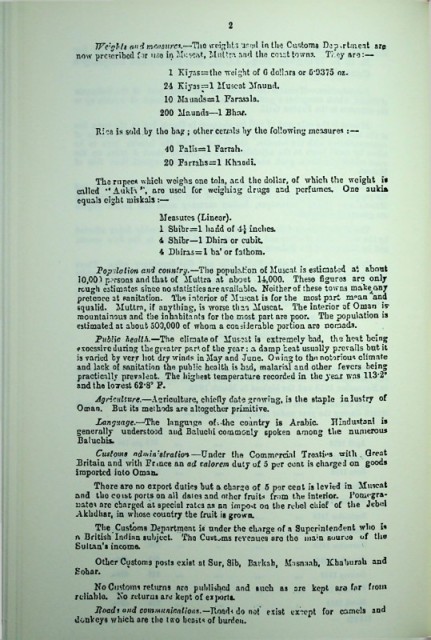Page 322 - 7 Persian Trade rep Muscat 1_Neat
P. 322
2
Wrights and measure*.—The weights us fid in the Customs Department arc
now prescribed Cor uso in Muscat, Muttra and the coast towns. They are:—
1 Kiyas—tlic weight of G dollars or 6*9375 oz.
2*1 Kiyas~=l Muscat Maund.
10 Maundsssl Farasala.
200 Maunds—1 Bhar.
Kicc is sold by tho bn? ; other corrals by the following measures :—
40 Palis=l Farrah.
20 Farralis=l Khaodi.
The rupees which weighs one tola, and the dollar, of which the weight i«
called “Aukh”, aro used for weighing drugs and perfumes. One aukia
equals eight miskals :—
Measures (Linear).
1 Sbibr=l hand of 4-i Inches.
4 Shibr—1 Dhira or cubit,
4 Dhirasssl ba’ or fathom.
Population and country.—Tho population of Muscat is estimated at about
10,001 persons and that of Muttra at about 14,000. These figures are only
rough estimates since no statistics are available. Neither of these towns make^any
pretence at sanitation. The interior of Muscat is for the most part m°an and
squalid. Muttra, if anything, is worse than Muscat The interior of Oman is*
mountainous and the inhabitants for the most part are poor. The population is
estimated at about 500,000 of whom a considerable portion are nomads.
Public health.—Tho climate of Muscat is extremely bad, the heat being
exoessive during the greater part of the year: a damp heat usually prevails but it
is varied by very hot dry winds in May and June. Owing to tho notorious climate
and lack of sanitation tho public health is bsd, malarial and other fevers being
practically prevalent. The highest temperature recorded in the year was 113*2*
and tho lowest 62*85 F.
Agriculture.—Agriculture, chiefly date growing, is the staple inlustry of
Oman. But its methods are altogether primitive.
Language.—The language of-.-the country is Arabic. Hindustani is
generally understood aud Baluchi commonly spoken among the numerous
Baluchis.
Customs ndmirisiration—Under tho Commercial Treaties vritli . Great
Britain and with Frmce an ad valorem duty of 5 per cent is charged on goods
imported into Oman.
Thore aro no export duties but a.charge of 6 per cent is levied in Muscat
and tho coist ports on all daie3 and other fruits from the interior. Pomegra
nates are charged at special rates as an import on the rebel chief of the Jebel
Akkdhar, in whose country the fruit is grown.
The Customs Department is under the charge of a Superintendent who i«
n British Indian subject. The Customs revenues aro tho main source of the
Sultan’s income.
Other Customs posts exist at Sur, Sib, Barkah, Mnsnaah, Khaburah and
Sohar.
No Customs returns are published and such as are kept ora far from
rcliablo. No returns arc kept of exports.
Roadf and communications.—Pioadn do not exist except for camels and
donkeys which are tho two boost* of burden.

